Life style
The many faces of betel leaf
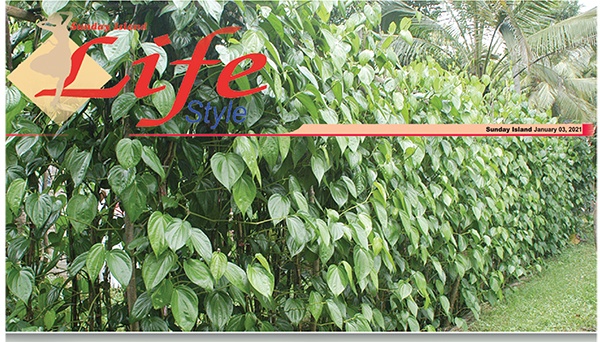
by Randima Attygalle
A motif of prosperity, new beginnings and goodwill, the betel leaf interlaces the multi-cultural Sri Lankan society. Bulath in Sinhalese and Vettilai in Tamil, this glossy heart-shaped leaf of cultural and religious connotations, is an ‘evergreen presence’ at many a moment of Lankan lives. Among the 40 leaves of the standard betel sheaf or bulath hurulla lie a sense of welcome, reverence, renewed family ties, forgiveness and blessings.
 Be it the first glimpse of a future wife-to-be over a bulath heppuwa (betel tray) offered by her, a mark of respect to village weda mahattaya, invoking the blessings of a parent, teacher or an elder, first business transaction for the new year, deheth watti offered to the priests, customs at weddings, rituals at the temple or kovil, betel is ubiquitous.
Be it the first glimpse of a future wife-to-be over a bulath heppuwa (betel tray) offered by her, a mark of respect to village weda mahattaya, invoking the blessings of a parent, teacher or an elder, first business transaction for the new year, deheth watti offered to the priests, customs at weddings, rituals at the temple or kovil, betel is ubiquitous.
Legend has it that the betel leaf originated in the mythical land of nagas and was brought to the world of humans by a cobra or a nagaya holding the leaf by its tip. This belief renders it the name nagavalli or snake creeper in Telegu. Interestingly, betel chewers discard the tip and the stalk of the leaf before they chew it. This evergreen climber is believed to have been introduced to us and other South Asian countries by the Chinese and Arab merchants who brought it from Malaysia and the surrounding East Asian region.
Apart from its significance in religious canon including jataka stories, betel is mentioned in historical sources such as Mahabharatha, Mahavansa and Ramayana, says Senarath Wickramasinghe, Deputy Director (Cultural), Department of National Museums. Stone inscription in Mihintale, according to Wickramasinghe, is one of the earliest historical sources of ours which alludes to betel by its reference to deheth offered to the priests. “Sharing of betel and its accompanying condiments of dried tobacco, slake lime or chunam and arecanut for a chew remains a cultural expression of friendship and brotherhood in traditional Sri Lankan social life,” says Wickramasinghe. A carefully arranged betel tray along with these condiments in the open verandah of a village home is an invitation to any visitor to have a chew. Today it is a diminishing sight and the other essentials once associated with betel chewing have become things of the past.
The betel bags (bulath malu), chunam boxes (hunu killotaya), betel tray (hepppuwa) and arecanut slicer (giraya) were elaborately designed reflecting the skill of the ancient Sri Lankan artisan. “While chunam boxes from Anuradhapura and Polonnaruwa periods have been found, the oldest betel bags intricately embroidered, date back to the Kandyan period,” says the Museum official who goes onto note that while the nobility used betel trays cast in bronze or brass, the ordinary folk used a tray made out of reed called ‘kooru adiya.’ The chunam boxes found either in copper or brass were also ornamented. The giraya often made in brass was embellished with native fauna and flora patterns. Its head was designed in various shapes including that of a woman in a greeting position.
The royals and aristocrats had their attendants carrying their betel related paraphernalia including the spittoon (padikkama) and the betel pounder or bulath wangediya. The colonial historians too record this local indulgence in their work. The water colour painting of the betel leaf by the Dutch painter Jan Brandes in his work, The World of Jan Brandes 1743-1808 and the illustration of a local Catholic woman going to church accompanied by a maid carrying a betel box and a spittoon in Illustrations and views of Dutch Ceylon 1602-1796 are among these records.
More than an indulgence, betel is today one of our major exports, Pakistan being the largest importer. Middle East, Canada, USA, Japan, UK, Australia, Norway and Germany are among the other leading importers. The other major betel growing countries are India, Thailand and Bangladesh.
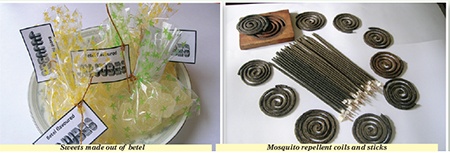 “Even though the betel leaves contain different types of important chemicals, no value added betel products are reported from any of these importing countries. Almost all the countries import betel for chewing purposes as there is a considerable immigrant population of betel chewers in them,” says Dr. H.M.P.A Subasinghe, Director (Research), Inter-cropping and Betel Research Station, Department of Export Agriculture (DEA). The betel quid, as Subasinghe further explains is of different types with condiments which accompany it varying from country to country. The betel quid has regional differences as well he says. Cloves and cardamom are sometimes added to the quid of tobacco with lime and arecanut.
“Even though the betel leaves contain different types of important chemicals, no value added betel products are reported from any of these importing countries. Almost all the countries import betel for chewing purposes as there is a considerable immigrant population of betel chewers in them,” says Dr. H.M.P.A Subasinghe, Director (Research), Inter-cropping and Betel Research Station, Department of Export Agriculture (DEA). The betel quid, as Subasinghe further explains is of different types with condiments which accompany it varying from country to country. The betel quid has regional differences as well he says. Cloves and cardamom are sometimes added to the quid of tobacco with lime and arecanut.
While betel is grown across the island, the export quality crop of thick dark green known as Kalu bulath is found in Kurunegala, Gampaha, Kegalle, Kalutara and Colombo districts. Different cultivars are grown by farmers including Mahamaneru, Kudamaneru, Ratadalu, Galdalu and Gatathodu. For commercial purposes, Mahamaneru and Ratadalu are the most commonly grown. The Inter-cropping and Betel Research Station of the DEA, through a series of plant breeding programmes, had released two high yielding varieties with high quality parameters named Naram mali and Naram rathi.
Betel Leaf Blight (BLB) disease is the most feared in betel cultivation. “This could destroy an entire cultivation within a few weeks,” explains Subasinghe who notes that research is in progress to evaluate different traditional treatments used by farmers to fight the disease.
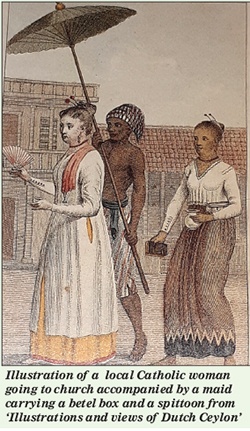 Several value-added betel products have already been located by the Betel Research Station, its Director said. Betel flavoured sweets, betel oil, mosquito repellents, sticks and creams, betel mixed shampoo, betel mixed herbal tea and a betel drink are among them. Research is also underway to develop toothpaste, mouthwash, face cream, anti-tick lotion, anti-tick powder, wound healing creams, cold drinks, chocolates, incense sticks, appetizers, digestive agents and tonics. “These value added products can boost the marketability of betel and create new prospects in the industry,” notes Subasinghe.
Several value-added betel products have already been located by the Betel Research Station, its Director said. Betel flavoured sweets, betel oil, mosquito repellents, sticks and creams, betel mixed shampoo, betel mixed herbal tea and a betel drink are among them. Research is also underway to develop toothpaste, mouthwash, face cream, anti-tick lotion, anti-tick powder, wound healing creams, cold drinks, chocolates, incense sticks, appetizers, digestive agents and tonics. “These value added products can boost the marketability of betel and create new prospects in the industry,” notes Subasinghe.
Betel is also rich in medicinal properties. The potential for betel-based anti-diabetic and gastro protective drugs are many says the scientist. “Anti-fungal, anti-bacterial and anti-protozoan properties of betel can kill or inhibit some bacteria which cause diseases such as typhoid, cholera and tuberculosis. Its antioxidant properties have a cancer preventive effect. Research has also revealed that betel oil is rich in healing properties. Betel leaves can also prevent indigestion, bronchitis, constipation, congestion, coughs and asthma.”
(Pic credit Department of Export Agriculture and Department of National Museums)
- News Advertiesment
See Kapruka’s top selling online shopping categories such as Toys, Grocery, Flowers, Birthday Cakes, Fruits, Chocolates, Clothing and Electronics. Also see Kapruka’s unique online services such as Money Remittence,News, Courier/Delivery, Food Delivery and over 700 top brands. Also get products from Amazon & Ebay via Kapruka Gloabal Shop into Sri Lanka.
Life style
LUXASIA aims to lead luxury beauty’s growth in Sri Lanka
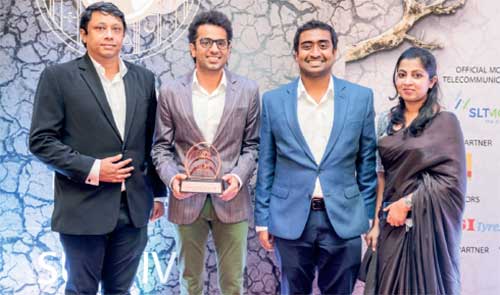
Sri Lanka is a land renown for stunning natural beauty. Yet, LUXASIA still managed to usher in a different kind of beautiful to the market through its expertise in luxury beauty retail and omni-distribution.
In November 2019, LUXASIA unveiled its inaugural classy beauty counters at Odel, One Galle Face. Since then, it has brought enchanting fragrances from luxury brands such as Burberry, Calvin Klein, Gucci, and Marc Jacobs, as well as trendy skincare from KORA Organics to beauty-lovers in an exquisite and captivating retail format.
Now, having successfully overcome the challenges in 2020 imposed by COVID-19 and related lockdowns, LUXASIA is ready and excited to thrill Sri Lankan consumers again. This time, it is with the launch of both skincare and make-up collections from the prestigious Japanese beauty brand, Shiseido. Arriving with a glamorously magnificent pop-up at One Galle Face from 8 to 14 February 2020, LUXASIA promises to bring memorable consumer experiences and a feast for the eyes that showcases the best in Japanese beauty.
Leading up to this pop-up, LUXASIA partnered the Key Opinion Leaders (KOLs) and top influencers of Sri Lanka to excite the beauty community with a sneak peek of what Shiseido have to offer. This campaign garnered more than 100,000 social interactions, with over 1.2 million social media impressions, piquing consumers’ fascination in Shiseido’s award-winning and best-selling serum, The Ultimune Power Infusing Concentrate.
Looking ahead into 2021, LUXASIA aims to continue delighting consumers with even more fresh retail innovations to spice up the luxury beauty scene in Sri Lanka. Soon, fragrance enthusiasts can expect a unique pop-up of all the scents that Luxasia carry, featuring new launches from Davidoff and Calvin Klein, as well as other interesting novelties. Beauty-lovers can also expect more limited edition products and gifts-with-purchases, interesting workshops, as well as seasonal offerings in the coming months. Concurrently, LUXASIA also aspires to continue grooming the Sri Lankan beauty community through more entertaining collaborations with KOLs throughout 2021.
LUXASIA sees immense potential in Sri Lanka’s fast-growing beauty market and has been its voice in the international beauty industry. For some time now, LUXASIA has been relentlessly reaching out to numerous luxury beauty brands across to world to interest them in Sri Lanka. While it is encouraging to see the first-fruits, LUXASIA is aiming much higher. Forging ahead, LUXASIA strives to champion and lead the growth of luxury beauty in Sri Lanka, through even more partnerships with great brands, and by continuously delighting consumers.
Life style
Newly published guide opens many windows on whale watching
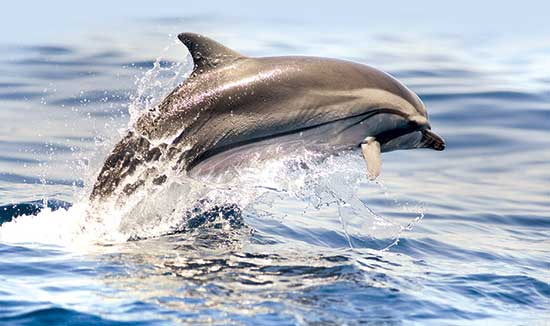
by Ifham Nizam
Shipping lanes to the south of Dondra pose the threat of ships colliding with whales as the area has very rich marine life which also attracts whale watching boats, says prolific wildlife writer and photographer Gehan de Silva Wijeyeratne, author of the recently published ‘A Naturalist’s Guide to the Mammals of Sri Lanka’.
He says international shipping industry organizations have written to the government to push back the existing shipping lanes and if no action is initiated, there is the danger of whale watching boats colliding with vessels.
Dr. Susannah Calderon and her colleagues at the University of Ruhuna have recommended the shipping lanes be moved 15 nautical miles south. The cost impact to all concerned will be negligible, but it significantly improves safety at sea, especially at night when the sea is dotted with the lamps from hundreds of small fishing crafts in the path of giant container carriers.
“It is primarily a safety issue though an important secondary impact will be that it reduces fatal collisions with whales, while generating favourable publicity for the government of Sri Lanka. It boils down to moving the shipping lanes further south and saving lives, Wijeyeratne stressed in an interview with The Sunday Island.
Asked what’s special about his latest publication, he said: “This is the first photographic field guide which covers nearly all of the mammals found in Sri Lanka. It covers 96 per cent of the land and marine mammals. The book, which is portable and affordable, also contains a large number of images from 40 photographers which are practically useful in the field to identify 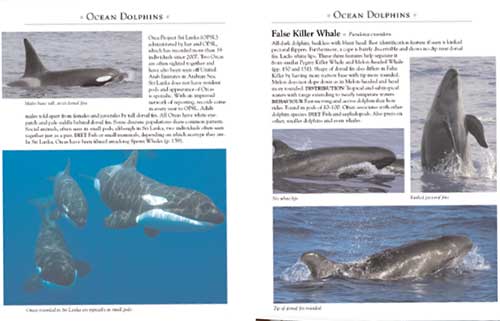 a mammal to species level. It also covers a number of small, discrete, nocturnal mammals whose existence that even many local wildlife enthusiasts will not be aware of.”
a mammal to species level. It also covers a number of small, discrete, nocturnal mammals whose existence that even many local wildlife enthusiasts will not be aware of.”
On the book’s coverage of the marine mammals, Wijeyeratne said there are two noteworthy aspects. Firstly, it covers all the species recorded in Sri Lankan waters expect for one, the Omura’s Whale. This will be included in a second edition. Secondly, it uses images of the whales and dolphins (cetaceans) which will show the animals the way a whale watcher will see them on the surface.
Artwork that shows the whole animal is important, but in field conditions, they are often of limited value to identify cetaceans which only show a little of their upper body in sections at a time they surface.
Q: You were the first to publicize that Sri Lanka was the best location for Blue Whale sightings and offered the best chance to see a superpod of Sperm Whales. Can you explain briefly how you set about branding Sri Lanka as a top international destination for whale watching?
A:
I started with field work to ascertain the facts and launched a media campaign initially with Jetwing Eco Holidays and Jetwing Hotels which was supported over many years by the Sri Lanka Tourism Promotion Bureau (SLTPB) and others in the media and tourism business. I have published 37 articles on whale watching in Sri Lanka. The first, in May 2008, was pivotal as it boldly stated that Sri Lanka was best for Blue Whales. This set everything in motion. My articles give due credit to many people who were a part of this amazing story. This includes Dr. Charles Anderson who first told me it would be feasible to see Blue Whales from the South.
A Belgian millionaire philanthropist who prefers to remain anonymous and helped create the infrastructure for whale watching by 13 tsunami affected fishing youth who set up Mirissa Water Sports and Sue Evans who was important for connecting all of us and Anoma Alagiyawadu (the Jetwing Lighthouse Naturalist) whom I tasked with collecting the initial data for the Encounter Rates I publicized in the media.
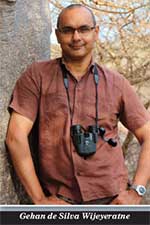 Remarkably, no Sri Lankan marine biologist played any role in publicizing whale watching in the early years. However, soon after, they benefited by being thrust into the media spotlight by film crew researchers who had read the publicity which began with my various widely disseminated articles. Having read them, and sometimes after conversations with me, the film crews and the press came to Sri Lanka and incorporated local marine biologists into their story.
Remarkably, no Sri Lankan marine biologist played any role in publicizing whale watching in the early years. However, soon after, they benefited by being thrust into the media spotlight by film crew researchers who had read the publicity which began with my various widely disseminated articles. Having read them, and sometimes after conversations with me, the film crews and the press came to Sri Lanka and incorporated local marine biologists into their story.
At the time I broke the first story, I do not think any of the local marine biologists had even one image of a Blue Whale of a publishable standard or had any idea that Sri Lanka was the best place in the world to see Blue Whales. Hopefully, the increased profile of local marine biologists has made it easier for them to raise the funds needed for their important research.
Q: Did the Sri Lanka Tourism Promotion Bureau help your efforts with publicity and branding?
A:
Yes indeed. At the start of the publicity campaign, we produced a series of informative and attractive publications designed by Chandrika Maelge. These were printed and distributed at key consumer and travel trade fairs such as the Bird Fair, WTM and Destinations where a number of important press and tour operators were informed about Sri Lanka being a good place for whales. At some of the press drinks events in London hosted by Jetwing Eco Holidays, around 35-45 press people would attend. These events were held in collaboration with the London Office of the SLTPB.
In some years, As many as three of these press events were held allowing personal interaction with a wide pool of media people. Another important and later development is the role played by Nalin Perera who ran the SLTPB office in London for several years and attended many consumer and travel trade fairs. I had developed media briefs for him which he would print and distribute. In one conversation, he estimated that he had printed and distributed over 10,000 copies of this material.
There were others who also disseminated my stories to the international press; a notable example being Chitral Jayatilake who shared my publicity pdfs with various wildlife documentary makers he invited to Sri Lanka.
Q: Did everyone readily embrace your ideas?
It took a couple of years. I remember even into the second year of the publicity campaign there were doubts from the big companies in tourism.
I remember Srilal Miththapala who was then President of The Hotels Association of Sri Lanka speaking to me and joining a celebrity whale watching event I was leading with Shyamalee Tudawe. This was organized by Olivia Richli of the Amangalla in Galle.
Srilal wanted to report back to the association if there was any truth to the claims being made by me about how easy it was to see Blue Whales. On the coastline, the people running small guesthouses readily embraced the story as tourists who were reading my stories turned up with copies of my articles and asked for boats to take them whale watching. The international press also readily took it on as I provided credible data.
Q: What do you say to criticisms that whale watching needs better regulation?
I agree on the need for better regulation and higher standards. The tourism industry has played its part in publicizing whale watching. Other state agencies also need to step up their efforts to regulate the industry in a way that is good for the welfare of the animals and provide a good visitor experience.
Q: What do you expect ‘A Naturalist’s Guide to the Mammals of Sri Lanka’ to achieve?
I would like people to understand that there is still a lot to be discovered about Sri Lanka’s mammals and I hope this portable and affordable guide will find its way into the hands of local naturalists and inspire more research and more practical steps to conserve habitats and species.
Life style
Modern Brides and Grooms collection by LOVI Ceylon and friends

Brides and Grooms of Sri Lanka – Reimagined
“Together we’re creating moments of happiness and cherished memories for the new couple and their families” said Founder and CEO of LOVI Ceylon, Asanka de Mel, as he introduced LOVI Ceylon’s Groom collection. Each groom’s look was paired with extraordinary creations from Sri Lanka’s top bridal designers, jewelers, florists, hair and make-up artiste and was captured by story-telling photographers.
The presentation graciously hosted by the Taj Samudra and Shangri-La hotels saw 30 leading designers working hand in hand to infuse fresh ideas, celebrate cultural diversity and show-off Sri Lankan couture—the island’s hand craft heritage.
The stunning bridal costumes were painstakingly made by renowned designers Messrs. Dhananjaya Bandara, Rishard Raheem, and Michael Wijesuriya as well as Mses. Indi Yapa Abeywardena of Brides by INDI, Sonali Dharmawardena, Darshi Keerthisena of Buddhi Batiks, Ramona Oshini, Sandani Perera of IKIGAI Bridal, and Jaish Parathalingam of Aashkii. The newcomer, Ms. Anusha David also presented her couture creations under the label Gabriel.
“We want our Groom and all of the men in the wedding including the groomsmen, dads, young boys and friends, to be themselves–to feel rooted in culture, well dressed and at ease on the wedding day,” says Asanka. Celebrating the religious and cultural traditions including Buddhist, Christian, Hindu, Kandyan, Malay, Muslim, Sinhala, Tamil and western traditions of the island LOVI Ceylon’s Grooms’ range presented modern sarongs paired with formal shirts, jackets, kurtas and more. They were paired with sarees, dresses, lehengas, pant suits and an array of breathtaking outfits. There were many looks offered for the Sri Lankan diaspora, as well as couples seeking inspiration for destination weddings.
As the designs progressed from sketch to stitching, our jewelry partners Careems, Lalitha, Mallika Hemachandra, Tiesh and Vogue jewelers added their brilliant sparkles with handcrafted fine jewelry made of precious metals encrusted with diamonds, sapphires and rubies. And what wedding would be complete without flowers? Bringing the latest floral creations were florists Designer Flowers, Flowers by Joan and Karen Forbes, Lassana Flora, and Supreme Flora who made the spectacular bridal outfits blossom with their creations.
Breathing life into these wonderful creations with superb hair and make-up was anchor of the shoot, Ms. Nadiya Fernando and her collaborator Omesh, while Ramani Fernando Salons, Shane Perera, Viran Peter, Brides by Leena and Talia designs, also worked magic on the models.
The father son duo Dinuka and Dineth Fonseka of Studio3000 took on the herculean task of capturing all the creations as the anchor photography partner. The works of Ashene Bernard, Amarante Studio, Geeshan Bandara, and Portrait Culture were also presented in imaginative and artistic captures.
De Mel expressed his thanks to the wonderful models who brought the visions and fancies of the designers to life, as well as poet and author Ashok Ferrey for being the MC of the shoot and providing an eloquent commentary, delivered with his inimitable panache!
“We have world class craftsmanship here, it’s fun to work with so many experts, who just happen to be friends, to present a beautiful collection that could nudge the course of Sri Lankan clothing identity” said Asanka when asked about the work that went into this.
As he rightly reminded the gentlemen to choose wisely, “on that special wedding day, when all eyes are on her–her eyes are on you!”









